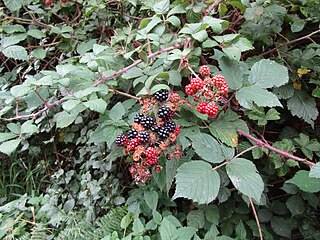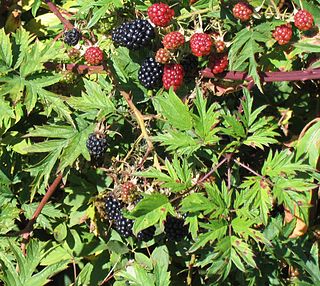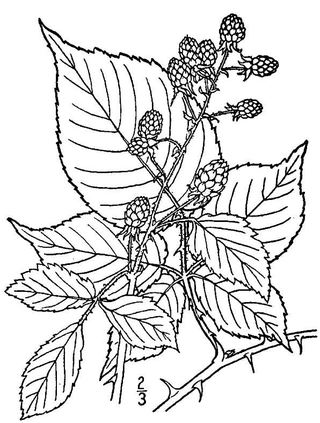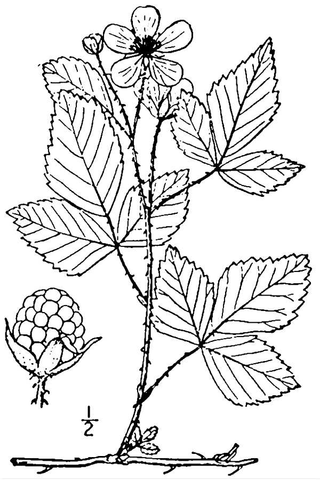
Rubus is a large and diverse genus of flowering plants in the rose family, Rosaceae, subfamily Rosoideae, with over 1,350 species, commonly known as brambles.

Rubus caesius is a Eurasian species of dewberry, known as the European dewberry. Like other dewberries, it is a species of flowering plant in the rose family, related to the blackberry and raspberry. It is widely distributed across much of Europe and Asia from Ireland and Portugal as far east as Xinjiang Province in western China. It has also become sparingly naturalized in scattered locations in Argentina, Canada, and the United States.

Rubus saxatilis, or stone bramble, is a species of bramble widespread across Europe and Asia from Iceland and Spain east as far as China. It has also been found in Greenland.

Rubus laciniatus, the cutleaf evergreen blackberry or evergreen blackberry, is a species of Rubus, native to Eurasia. It is an introduced species in Australia and North America. It has become a weed and invasive species in forested habitats in the United States and Canada, particularly in the Northeast and along the Pacific Coast.

Rubus armeniacus, the Himalayan blackberry or Armenian blackberry, is a species of Rubus in the blackberry group Rubus subgenus Rubus series Discolores Focke. It is native to Armenia and northern Iran, and widely naturalised elsewhere. Both its scientific name and origin have been the subject of much confusion, with much of the literature referring to it as either Rubus procerus or Rubus discolor, and often mistakenly citing its origin as western European. Flora of North America, published in 2014, considers the taxonomy unsettled, and tentatively uses the older name Rubus bifrons.

Rubus ursinus is a North American species of blackberry or dewberry, known by the common names California blackberry, California dewberry, Douglas berry, Pacific blackberry, Pacific dewberry and trailing blackberry.

Rubus ulmifolius is a species of wild blackberry known by the English common name elmleaf blackberry or thornless blackberry and the Spanish common name zarzamora. It is native to Europe and North Africa, and has also become naturalized in parts of the United States, Australia, and southern South America.

Rubus pubescens is a herbaceous perennial widespread across much of Canada and the northern United States, from Alaska to Newfoundland, south as far as Oregon, Colorado, and West Virginia.

Rubus flagellaris, the northern dewberry, also known as the common dewberry, is a North American species perennial subshrub species of dewberry, in the rose family. This dewberry is distributed across much of Canada, Mexico, and the United States. It grows in diverse habitats ranging from drier savannas to temperate deciduous forests.

Rubus allegheniensis is a North American species of highbush blackberry in Section Alleghenienses of the genus Rubus, a member of the rose family. It is the most common and widespread highbush blackberry in eastern and central North America. It is commonly known as Allegheny blackberry.
Rubus aboriginum is a North American species of dewberry, known as the garden dewberry and aboriginal dewberry. Like other dewberries, it is a species of flowering plant in the rose family, related to the blackberry. It is native to the United States and Mexico, primarily in the southern Great Plains.

Rubus invisus is a species of dewberry, known as upland dewberry. Like other dewberries, it is a species of flowering plant in the rose family, related to the blackberry. It is found in the eastern and east-central United States.
Rubus biformispinus, the pasture dewberry, is an uncommon North American species of flowering plant in the rose family. It is found in eastern and central Canada and the northeastern United States.

Rubus elegantulus, the showy blackberry, is an uncommon North American species of flowering plant in the rose family. It grows in the northeastern and north-central United States and eastern Canada.
Rubus noveboracus is an uncommon North American species of flowering plant in the rose family. It grows in the northeastern and north-central United States and eastern Canada (Québec).
Rubus hypolasius is an uncommon North American species of flowering plant in the rose family. It grows in the east-central United States.
Rubus recurvicaulis is an uncommon North American species of flowering plant in the rose family. It grows in eastern and central Canada and the north-central and northeastern United States.
Rubus rossbergianus is an uncommon North American species of flowering plant in the rose family. It grows in northeastern United States.
Rubus plicatifolius is a North American species of dewberry in the rose family. It is found in eastern and central Canada and in the eastern and central United States.
Rubus roribaccus a North American species of brambles in the rose family, called the Lucretia blackberry. It grows in eastern Canada (Québec) and the eastern and central United States.












